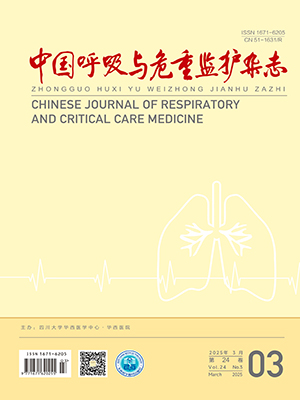| 1. |
Casal-Dominguez M, Pinal-Fernandez I, Pak K, et al. Performance of the 2017 European Alliance of Associations for Rheumatology/American College of Rheumatology Classification Criteria for Idiopathic Inflammatory Myopathies in Patients with Myositis-Specific Autoantibodies. Arthritis Rheumatol, 2022, 74(3): 508-517.
|
| 2. |
Vincze M, Danko K. Idiopathic inflammatory myopathies. Best Pract Res Clin Rheumatol, 2012, 26(1): 25-45.
|
| 3. |
Targoff IN, Johnson AE, Miller FW. Antibody to signal recognition particle in polymyositis. Arthritis Rheum, 1990, 33(9): 1361-1370.
|
| 4. |
Gunawardena H, Betteridge ZE, Mchugh NJ. Myositis-specific autoantibodies: their clinical and pathogenic significance in disease expression. Rheumatology (Oxford), 2009, 48(6): 607-612.
|
| 5. |
Travis WD, Costabel U, Hansell DM, et al. An official American Thoracic Society/European Respiratory Society statement: Update of the international multidisciplinary classification of the idiopathic interstitial pneumonias. Am J Respir Crit Care Med, 2013, 188(6): 733-748.
|
| 6. |
Hansell DM, Bankier AA, Macmahon H, et al. Fleischner Society: glossary of terms for thoracic imaging. Radiology, 2008, 246(3): 697-722.
|
| 7. |
Lynch DA, Sverzellati N, Travis WD, et al. Diagnostic criteria for idiopathic pulmonary fibrosis: a Fleischner Society White Paper. Lancet Respir Med, 2018, 6(2): 138-153.
|
| 8. |
Khanna D, Mittoo S, Aggarwal R, et al. Connective tissue disease-associated interstitial lung diseases (CTD-ILD) - Report from OMERACT CTD-ILD Working Group. J Rheumatol, 2015, 42(11): 2168-2171.
|
| 9. |
王迁, 李梦涛. 2018中国结缔组织病相关间质性肺病诊断和治疗专家共识. 中华内科杂志, 2018, 57(8): 558-565.
|
| 10. |
Romisch K, Miller FW, Dobberstein B, et al. Human autoantibodies against the 54 kDa protein of the signal recognition particle block function at multiple stages. Arthritis Res Ther, 2006, 8(2): R39.
|
| 11. |
Satoh M, Tanaka S, Ceribelli A, et al. A comprehensive overview on myositis-specific antibodies: new and old biomarkers in idiopathic inflammatory myopathy. Clin Rev Allergy Immunol, 2017, 52(1): 1-19.
|
| 12. |
Gono T, Kuwana M. Current understanding and recent advances in myositis-specific and -associated autoantibodies detected in patients with dermatomyositis. Expert Rev Clin Immunol, 2020, 16(1): 79-89.
|
| 13. |
Anquetil C, Boyer O, Wesner N, et al. Myositis-specific autoantibodies, a cornerstone in immune-mediated necrotizing myopathy. Autoimmun Rev, 2019, 18(3): 223-230.
|
| 14. |
Pinal-Fernandez I, Casal-Dominguez M, Mammen AL. Immune-mediated necrotizing myopathy. Curr Rheumatol Rep, 2018, 20(4): 21.
|
| 15. |
Suzuki S, Nishikawa A, Kuwana M, et al. Inflammatory myopathy with anti-signal recognition particle antibodies: case series of 100 patients. Orphanet J Rare Dis, 2015, 10: 61.
|
| 16. |
Ge YP, Yang HB, Xiao XY, et al. Interstitial lung disease is not rare in immune-mediated necrotizing myopathy with anti-signal recognition particle antibodies. BMC Pulm Med, 2022, 22(1): 14.
|
| 17. |
Hanaoka H, Kaneko Y, Suzuki S, et al. A unique case of polymyositis with anti-signal recognition particle antibody complicated by subacute interstitial lung disease and subluxing arthropathy, resembling anti-synthetase syndrome. Mod Rheumatol, 2016, 26(6): 979-980.
|
| 18. |
Kao AH, Lacomis D, Lucas M, et al. Anti-signal recognition particle autoantibody in patients with and patients without idiopathic inflammatory myopathy. Arthritis Rheum, 2004, 50(1): 209-215.
|
| 19. |
Malkan A, Cappelen-Smith C, Beran R, et al. Anti-synthetase syndrome associated with anti PL-12 and anti-signal recognition particle antibodies and a necrotizing auto-immune myositis. J Clin Neurosci, 2015, 22(2): 396-398.
|
| 20. |
Rams A, Kosalka-Wegiel J, Kuszmiersz P, et al. Characteristics of idiopathic inflammatory myopathies with novel myositis-specific autoantibodies. Adv Clin Exp Med, 2021, 30(12): 1239-1248.
|
| 21. |
Gupta L, Naveen R, Gaur P, et al. Myositis-specific and myositis-associated autoantibodies in a large Indian cohort of inflammatory myositis. Semin Arthritis Rheum, 2021, 51(1): 113-120.
|
| 22. |
杨红霞, 田小兰, 江薇, 等. 免疫介导坏死性肌病的临床和病理特征分析. 北京大学学报(医学版), 2019, 51(6): 989-995.
|
| 23. |
Jiang DH, Liang JR, Hodge J, et al. Regulation of pulmonary fibrosis by chemokine receptor CXCR3. J Clin Invest, 2004, 114(2): 291-299.
|
| 24. |
Hervier B, Perez M, Allenbach Y, et al. Involvement of NK cells and NKp30 pathway in antisynthetase syndrome. J Immunol, 2016, 197(5): 1621-1630.
|
| 25. |
Galati D, De Martino M, Trotta A, et al. Peripheral depletion of NK cells and imbalance of the Treg/Th17 axis in idiopathic pulmonary fibrosis patients. Cytokine, 2014, 66(2): 119-126.
|
| 26. |
Xu HJ, Geddes R, Roberts-Thomson PJ. Low molecular weight IgM and CD5 B lymphocytes in rheumatoid arthritis. Ann Rheum Dis, 1994, 53(6): 383-390.
|
| 27. |
Zhan X, Yan W, Wang Y, et al. Clinical features of anti-synthetase syndrome associated interstitial lung disease: a retrospective cohort in China. BMC Pulm Med, 2021, 21(1): 57.
|




